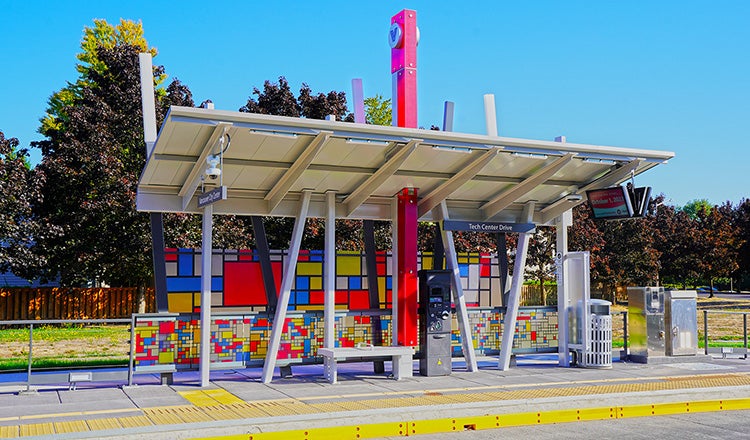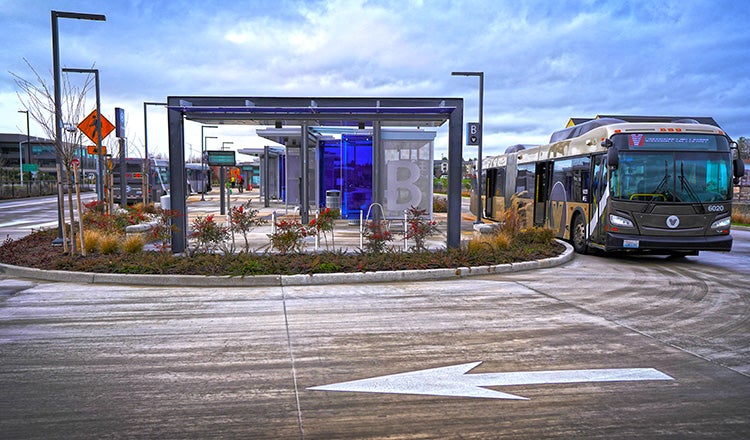Mill Plain Bus Rapid Transit

Mill Plain Bus Rapid Transit
Leveraging BRT Success to Streamline Delivery and Secure Funding
Building on the first bus rapid transit line in the region, C-TRAN began work on the second High-Capacity Transit corridor identified in in C-TRAN 2030, the agency’s long-range plan. The Mill Plain BRT Project is a $50 million dollar BRT project that runs approximately 10 miles along Mill Plain Boulevard between historic Downtown Vancouver and the growing Columbia Tech Center in East Vancouver. HDR has been with C-TRAN every step of the way, from planning through final design, helping C-TRAN to secure Federal Transit Administration’s Capital Investment Grant funding, and continuing into construction and implementation support.
HDR’s work identified speed and reliability improvements for a major east-west arterial to improve mobility options, enhance safety and access to transit, and integrate with pre-existing bicycle and pedestrian facilities. Together with our project partners, we analyzed existing and future conditions along the corridor, including operations, ridership, market demand, transit-dependent demographics and environmental issues to identify priority areas for stations and facility improvements. We also worked closely with C-TRAN to gather, evaluate and integrate lessons learned from their first BRT line to position Mill Plain BRT for successful delivery.
The BRT service operates primarily in mixed traffic, maintaining existing traffic lanes with a few key geometric and operational transit priority treatments. The project also includes a new nine-bay transit center with a full driver relief building and customer service office. Mill Plain Boulevard is a major east-west spine of Vancouver, with diverse land use patterns and varying corridor character, that includes many essential services, hospitals, clinics, colleges and multifamily affordable housing complexes. The service improves transit travel for nearly 3,000 passengers per day in a corridor that is expected to see rapid growth over the next 10 years.
Mill Plain BRT serves as an economic development driver, contributes to lower emissions, and provides high quality and safer mobility options for the community. Buses are faster with larger capacities, and stations have increased passenger amenities and safety features.

Designing to Cost, Staying on Schedule
HDR helped C-TRAN successfully navigate the FTA Capital Investment Grant process, which brought $24.9 million of funding to the $50 million project budget. We also helped secure other state and regional funding for the project.
With a budget set before design began, our team chose to diligently work within the funding and cost limits, rather than finalizing a design and then sending it out to bid in a conventional process. We developed creative solutions and evaluated cost throughout the design process to deliver the project under budget, $49.9 million. We analyzed the costs from the Fourth Plain BRT Project, C-TRAN’s first BRT line, and used our HDR expert estimators to tailor the project to meet the cost goal. For example, we moved stations to the edge of the travel lane to improve operations and to save right-of-way costs. We limited the size of the station platform based on existing operations, which better suited the need and environment. In another example, we standardized a consistent shelter canopy sized for all stations, reducing costs. We decreased grades to the platform to eliminate the need for expensive railing. While doing so, our team helped realize the needs of community partners, including developing unique station designs that guide people on bikes behind the stations, reducing conflicts with transit buses and transit riders. We also mitigated the impacts of the pandemic, keeping the project on schedule by juggling specific tasks judiciously to capitalize on the positive public perception of the first BRT line.
And despite the uncertainties related to supply chain and inflation risks that other projects have experienced because of the COVID-19 pandemic, contractors’ bids were in line with our engineering cost estimate. After a September 2021 groundbreaking featuring FTA Administrator Nuria Fernandez, construction began without any delays.

Design Services During Construction
During construction, C-TRAN determined that the plan for an initial opening in late November 2023 could be trimmed given efficiencies employed by the team during construction. The line opened instead on October 1, 2023.
Our team worked with the contractor to answer requests for information efficiently and quickly, streamlining the process and allowing for the earlier grand opening. Our structure allowed the team to be nimble and take on more work as needed, drawing from our flexible matrix organization to ensure a prompt and thorough response from architects, structural engineers and other disciplines.
Full Service
This project benefited from many of HDR’s services: planning, environmental, system infrastructure, fiber, federal funding strategy, FTA Small Starts grant preparation, civil design, landscape architecture, traffic, lighting, structural, electrical, communications, transit architecture, permitting, strategic communications / public involvement support, and right-of-way were all involved in the Mill Plain BRT. Having all these services in-house allowed for a smooth, streamlined delivery process, which continued throughout construction and project start-up.





